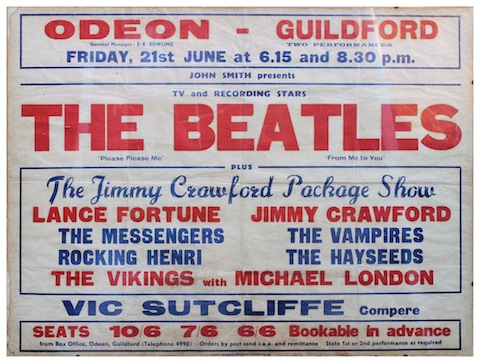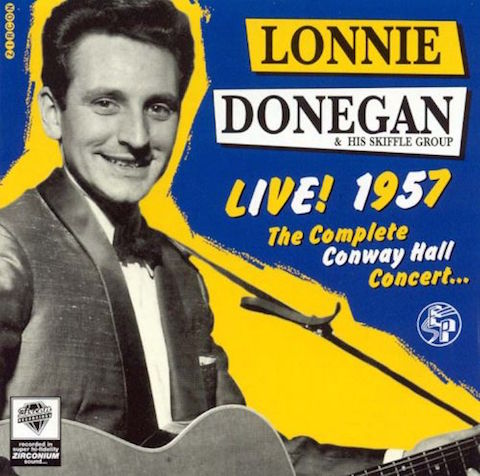 Abraham Lincoln
If given the truth, the people can be depended upon to meet any national crisis...
Abraham Lincoln
If given the truth, the people can be depended upon to meet any national crisis...
 Guildford news...
for Guildford people, brought to you by Guildford reporters - Guildford's own news service
Guildford news...
for Guildford people, brought to you by Guildford reporters - Guildford's own news service
Milestones in Rock ‘n’ Roll History: Rock Island Line
Published on: 15 Mar, 2018
Updated on: 25 Mar, 2018
In our new series of feature articles, Milestones in Rock ‘n’ Roll History, former Guildford journalist Dave Reading begins with a song that inspired a generation of musicians, including the Beatles.
In 1934 a group of black convicts held in an Arkansas state prison recorded a song that would eventually change the course of popular music.
The performance was led by a petty criminal named Kelly Pace and recorded by the pioneering musicologist John Lomax during one of several recording trips to southern state prisons. Lomax was assisted by the great Negro folk-blues singer Huddie Ledbetter (known to prison inmates as Lead Belly).
The song that Lomax captured for the world on his bulky, mobile recording machine was called Rock Island Line. It was a majestic performance, sung unaccompanied, coming from deep within the souls of a small group of hardened convicts with little to look forward to except years of incarceration. The song began with a message of spiritual hope.
Jesus died to save me in all of my sins,
In glory to God we’re going to meet him again.
It then went on to tell the curious story of a train that seemed to break the laws of speed and time.
The train left Memphis at half past nine,
Well it made it back to Little Rock at eight forty nine.
Hearing Rock Island Line for the first time, Lead Belly transformed it. The song went through various changes down the years until eventually it found itself included on a long playing record called New Orleans Joys, released on the Decca label in 1955 by Chris Barber’s Jazz Band. The track was sung by a 24-year-old banjo player from Glasgow called Tony Donegan, who had taken the stage name of Lonnie in honour of his hero, the American jazz and blues musician Lonnie Johnson.
At the time, no one saw this recording as a landmark in rock ‘n’ roll history, but a landmark it was. It was a remarkable example of a little-known musical form called skiffle, which had evolved from American blues, folk and jazz influences in the 1920s.
The sleeve notes announced that six jazz tracks on the album were recorded by Chris Barber (trombone), Pat Halcox (cornet), Monty Sunshine (clarinet), Lonnie Donegan (banjo), Ron Bowden (drums) and Jim Bray (bass).
The other two tracks, Rock Island Line and John Henry, are attributed to a sub-group of the band, the Lonnie Donegan Skiffle Group.
Decca was cool about the song from the start and it almost didn’t see the light of day. Donegan’s widow, Sharon, told me: “When they went to Decca and showed them Rock Island Line as an example of what they wanted to record, the people at Decca didn’t want to know. But Lonnie was persistent. During a break for coffee, someone left the tape running and they took the opportunity to record the song.”
Decca didn’t realise they were sitting on a goldmine and it took two years for them to release Rock Island Line as a single. The story goes that so many radio listeners had requested the song that it was difficult for Decca to ignore it. Rock Island Line was released in 1956 and was an immediate hit in Britain and America. In Donegan’s own words, the song changed him from being a little banjo player sitting in the back of a jazz band to being the biggest star in Britain.
The record had a spectacular effect on British teenagers. They had already been stirred by rock ‘n’ roll, but with skiffle, you could be more than an observer – you could get in on the action. Skiffle could be tackled by just about anyone with half an ounce of musical ability. All you needed was a cheap acoustic guitar or banjo, a household washboard, a handful of thimbles to hit it with, and a tea chest bass.
To build the latter, you simply pushed a broom handle through the hole in an upturned tea chest and attached a piece of chord to form a sounding string. This acted as a cheap substitute for a stand-up bass. The guitar player just needed to make a stab at three chords and you had yourself a band.
The Beatles authority Mark Lewisohn has suggested that without skiffle, the Beatles might never have existed. John Lennon had already been overawed by Elvis Presley’s Heartbreak Hotel, released in 1956. In March 1957, having persuaded his guardian Aunt Mimi to buy him a £17 guitar, Lennon saw skiffle as a way of getting a band together. In parallel, the young, baby-faced Paul McCartney had also been inspired by Donegan, having seen him perform at the Liverpool Empire. Skiffle disappeared within a few years, but the seeds had been sown.

Beatles concert poster from their appearance at Guildford Odeon on June 21, 1963. Picture: Tracks Ltd.
Hank Marvin and Van Morrison have both acknowledged Rock Island Line as an inspiration. And paying tribute to Donegan after he died in 2002, Queen guitarist Brian May told BBC Radio: “He really was at the very cornerstone of English blues and rock….I think he’s probably the principal reason I picked up a guitar.”
According to numerous sources, Donegan received a mere £4 session fee for Rock Island Line because he wasn’t a contracted Decca artist.
But everything was just beginning for him. In 1956 he signed with Pye-Nixa and went on to have at least 30 hit singles. His reign in the charts ended in 1962 because by then it was time for others to take over. The Beatles had their first hit in October of that year with Love Me Do, signalling the end of an era.
Recent Articles
- Burglar Jailed Thanks To Quick Action of Ash Resident
- Highways Bulletin for December
- Birdwatcher’s Diary No.318 Some Pre-Christmas Rambles
- Merry Christmas and a Happy New Year to All Our Contributors and Readers!
- More Units Added to Solums’s Station Redevelopment
- Vehicle Stop on Epsom Road Leads to Prolific Drug Gang Being Put Behind Bars
- Local Political Leaders Respond to Publication of the English Devolution White Paper
- Flashback: Guildford All Lit Up For Christmas – Then And Now
- City Earn Themselves a Three Point Christmas Present
- Mayor’s Diary: December 23 – January 4


Search in Site
Media Gallery
Dragon Interview: Local Artist Leaves Her Mark At One of England’s Most Historic Buildings
January 21, 2023 / No Comment / Read MoreDragon Interview: Lib Dem Planning Chair: ‘Current Policy Doesn’t Work for Local People’
January 19, 2023 / No Comment / Read MoreA3 Tunnel in Guildford ‘Necessary’ for New Homes, Says Guildford’s MP
January 10, 2023 / No Comment / Read More‘Madness’ for London Road Scheme to Go Ahead Against ‘Huge Opposition’, Says SCC Leader
January 6, 2023 / No Comment / Read MoreCouncillor’s Son Starts Campaign for More Consultation on North Street Plan
December 30, 2022 / No Comment / Read MoreCounty Council Climbs Down Over London Road Works – Further ‘Engagement’ Period Announced
December 14, 2022 / No Comment / Read MoreDragon Interview: GBC Reaction to the Government’s Expected Decision to Relax Housing Targets
December 7, 2022 / No Comment / Read MoreHow Can Our Town Centre Businesses Recover? Watch the Shop Front Debate
May 18, 2020 / No Comment / Read More













Recent Comments